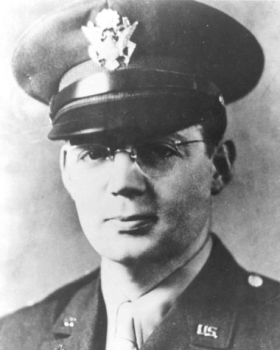John Patrick Washington was born on July 18, 1908 in Newark, New Jersey, one of seven children born to Irish immigrants Frank and Mary.
Even as a child, John exhibited a religious inclination and served as an altar server as a boy. It wasn’t a surprise, therefore, that as a teenager, he began the long road of study to become a Catholic priest. After studying at Immaculate Conception Seminary School of Theology at Seton Hall University, he was ordained priest in 1935.
For the next six years, Fr. John served in various New Jersey parishes. But after hearing of the Japanese bombing of Pearl Harbor, Hawaii on December 7, 1941, he joined the U.S. Army as a chaplain.
In late 1942, Fr. John was sent to Chaplains School at Harvard University. There, he met three other young chaplains who, with him, would one day become immortalized as “The Four Chaplains,” sometimes called, “The Immortal Chaplains.” In addition to Fr. John were: the Rev. George L. Fox, a Methodist minister from Pennsylvania; Rabbi Alexander D. Goode, a Reform Jewish rabbi from Brooklyn, New York; and the Rev. Clark V. Poling, a minister of the Reformed Church in America from Ohio. All four men were young first lieutenants.
On January 23, 1943, the four chaplains set sail on the USAT Dorchester with about 900 other men, both military and non-military. The ship was headed to Europe via Greenland. During the early morning hours of February 3, 1943, a German submarine torpedoed the Dorchester off of Newfoundland in the North Atlantic.
The torpedo knocked out the Dorchester’s electrical system, leaving the ship in darkness. Panic broke out among the men. The four chaplains tried to calm the men and organize an orderly evacuation of the ship. They guided many men to safety. When it became clear that there were not enough life jackets for everyone, the four chaplains took off theirs and gave it to other men.
As a result of the assistance of the chaplains, about 230 of the 904 men on the ship were saved.
One man, as he swam away from the ship, looked back. He reported that the flares had lit up the ship. The last thing he saw were the four chaplains standing together, praying for the safety of the men.
The four chaplains were all awarded posthumously the Distinguished Service Cross, the Purple Heart, and national acclaim. U.S. President Harry S Truman dedicated a chapel in their honor in 1951 in Philadelphia, and a U.S. postage stamp was issued in their honor in 1948. On July 14, 1960, the U.S. Congress established the Four Chaplains’ Medal and presented to the families of the chaplains at Fort Meyer, Virginia on January 18, 1961.



